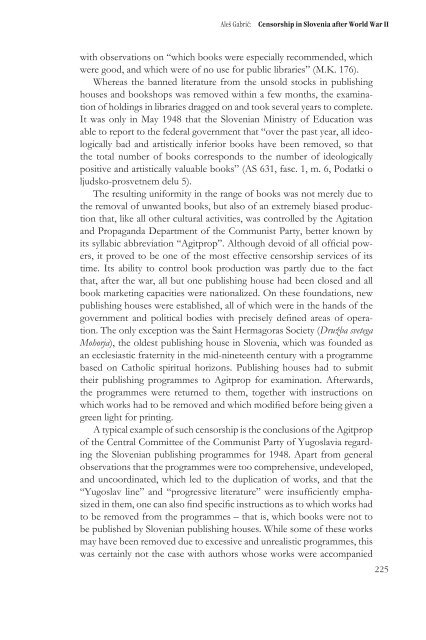Literatura in cenzura - Društvo za primerjalno književnost - ZRC SAZU
Literatura in cenzura - Društvo za primerjalno književnost - ZRC SAZU
Literatura in cenzura - Društvo za primerjalno književnost - ZRC SAZU
- No tags were found...
Create successful ePaper yourself
Turn your PDF publications into a flip-book with our unique Google optimized e-Paper software.
Aleš Gabrič:Censorship <strong>in</strong> Slovenia after World War IIwith observations on “which books were especially recommended, whichwere good, and which were of no use for public libraries” (M.K. 176).Whereas the banned literature from the unsold stocks <strong>in</strong> publish<strong>in</strong>ghouses and bookshops was removed with<strong>in</strong> a few months, the exam<strong>in</strong>ationof hold<strong>in</strong>gs <strong>in</strong> libraries dragged on and took several years to complete.It was only <strong>in</strong> May 1948 that the Slovenian M<strong>in</strong>istry of Education wasable to report to the federal government that “over the past year, all ideologicallybad and artistically <strong>in</strong>ferior books have been removed, so thatthe total number of books corresponds to the number of ideologicallypositive and artistically valuable books” (AS 631, fasc. 1, m. 6, Podatki oljudsko-prosvetnem delu 5).The result<strong>in</strong>g uniformity <strong>in</strong> the range of books was not merely due tothe removal of unwanted books, but also of an extremely biased productionthat, like all other cultural activities, was controlled by the Agitationand Propaganda Department of the Communist Party, better known byits syllabic abbreviation “Agitprop”. Although devoid of all official powers,it proved to be one of the most effective censorship services of itstime. Its ability to control book production was partly due to the factthat, after the war, all but one publish<strong>in</strong>g house had been closed and allbook market<strong>in</strong>g capacities were nationalized. On these foundations, newpublish<strong>in</strong>g houses were established, all of which were <strong>in</strong> the hands of thegovernment and political bodies with precisely def<strong>in</strong>ed areas of operation.The only exception was the Sa<strong>in</strong>t Hermagoras Society (Družba svetegaMohorja), the oldest publish<strong>in</strong>g house <strong>in</strong> Slovenia, which was founded asan ecclesiastic fraternity <strong>in</strong> the mid-n<strong>in</strong>eteenth century with a programmebased on Catholic spiritual horizons. Publish<strong>in</strong>g houses had to submittheir publish<strong>in</strong>g programmes to Agitprop for exam<strong>in</strong>ation. Afterwards,the programmes were returned to them, together with <strong>in</strong>structions onwhich works had to be removed and which modified before be<strong>in</strong>g given agreen light for pr<strong>in</strong>t<strong>in</strong>g.A typical example of such censorship is the conclusions of the Agitpropof the Central Committee of the Communist Party of Yugoslavia regard<strong>in</strong>gthe Slovenian publish<strong>in</strong>g programmes for 1948. Apart from generalobservations that the programmes were too comprehensive, undeveloped,and uncoord<strong>in</strong>ated, which led to the duplication of works, and that the“Yugoslav l<strong>in</strong>e” and “progressive literature” were <strong>in</strong>sufficiently emphasized<strong>in</strong> them, one can also f<strong>in</strong>d specific <strong>in</strong>structions as to which works hadto be removed from the programmes – that is, which books were not tobe published by Slovenian publish<strong>in</strong>g houses. While some of these worksmay have been removed due to excessive and unrealistic programmes, thiswas certa<strong>in</strong>ly not the case with authors whose works were accompanied225
















